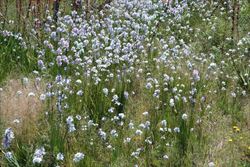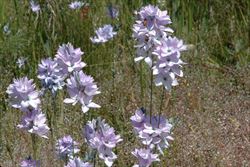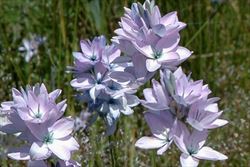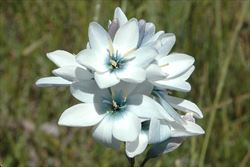Click on images to enlarge

infestation (Photo: Rob and Fiona Richardson)

habit (Photo: Rob and Fiona Richardson)

flower clusters on long stems (Photo: Rob and Fiona Richardson)

the mauve-flowered form of this species (Photo: Rob and Fiona Richardson)

the less common white-flowered form of this species (Photo: Rob and Fiona Richardson)
Scientific Name
Ixia polystachya L.
Synonyms
Ixia metelerkampiae L. Bolus (misapplied)Ixia viridiflora Lam. (misapplied)
Family
Iridaceae
Common Names
African corn lily, African cornlily, corn lily, variable ixia, white-and-yellow-flower cornlily
Origin
Native to southern Africa (i.e. Cape Province in South Africa).
Naturalised Distribution
Widely naturalised in southern Australia (i.e. in the coastal districts of central and southern New South Wales, in Victoria, in Tasmania, in south-eastern South Australia and on Kangaroo Island, and in south-western Western Australia.
Also naturalised overseas in south-western USA (i.e. California).
Notes
Variable ixia (Ixia polystachya) is regarded as an environmental weed in Victoria and Western Australia. It has escaped cultivation and become naturalised in open woodlands, in shaded moist sites, urban bushland, along roadsides, and in disturbed sites and waste areas. Like other corm and bulb producing species, variable ixia (Ixia polystachya) spreads from disturbed areas into nearby natural areas, crowding out the plants which native animals depend for food.
This species appears on local and regional environmental weed lists in Victoria (e.g. in Knox City and Nillumbik Shire) and has been recorded in Yarra Bend Park in suburban Melbourne. Variable ixia (Ixia polystachya) has also spread from old settlements into bushland and marri woodlands between Perth and Albany (including the Darling Ranges), in south-western Western Australia. It is also naturalised in the Sydney region and the Tathra-Bermagui area in New South Wales and has been recorded in several conservation areas in South Australia (i.e. in Belair National Park, Ferguson Conservation Park, Scott Creek Conservation Park and Cleland Conservation Park).

